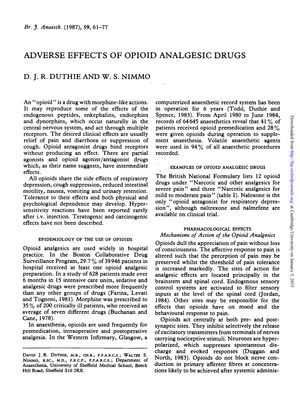ADVERSE EFFECTS OF OPIOID ANALGESIC DRUGS
January 1987
in “
British Journal of Anaesthesia
”

TLDR Opioid painkillers can cause many side effects, including breathing problems and addiction, but are generally considered safe when used properly.
In 1987, Duthie and Nimmo reviewed the adverse effects of opioid analgesic drugs, highlighting that these drugs can cause a range of side effects including respiratory depression, reduced intestinal motility, nausea, vomiting, urinary retention, tolerance, dependence, and hypersensitivity reactions. They noted that 29.7% of 39,946 hospitalized patients received opioids and that 35% of 200 critically ill patients were prescribed morphine. The review also discussed the benefits of opioid partial agonists, such as pentazocine and nalbuphine, which cause less severe respiratory depression than pure agonists. A study with 23 volunteers showed that nalbuphine 30 mg produced similar respiratory depression to morphine 20 mg, but without increased depression at higher doses. Additionally, opioids can cause cough suppression, cardiovascular issues due to histamine release, and gastrointestinal symptoms like constipation. The review also mentioned that opioids can affect blood flow, liver and biliary system function, and the central nervous system, potentially leading to cerebral toxicity and urinary retention. Furthermore, opioids can influence endocrine responses, cause blood disorders like thrombocytopenia and agranulocytosis, induce muscle rigidity, and cause skin reactions including alopecia areata. Despite these adverse effects, opioids are considered safe with a high therapeutic index, with respiratory depression being the most serious immediate effect treatable with antagonists like naloxone.
